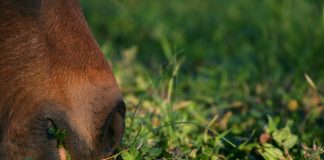In our Ask the Vet column, Dr. Lydia Gray answers your horse-health questions at HorseChannel.com/AskTheVet.
Q: With this time of year comes lots of mud and generally wet weather. What is the best way to prevent thrush, scratches and other diseases that come with spring?

A: This question was answered by SmartPak’s Hoof Health Consultant, Danvers Child, CJF (Certified Journeyman Farrier)
Providing regular maintenance and encouraging structural integrity of the hoof capsule is a primary concern when seeking to avoid problems associated with wet environments. In fact, my friend, Dr. Steven O’Grady, says the best tool for treating thrush is a farrier’s rasp. In effect, he’s saying that regular maintenance will minimize hoof capsule distortions and flares which provide pathways and “trappy” areas that hold and breed bacteria.
Nevertheless, in high moisture seasons, areas, and climates, it’s often necessary to provide more than regular trimming, especially when we look beyond thrush and add things like scratches to our list of concerns. While it’s often impossible to avoid the increased moisture, we can try to minimize exposure to muddy areas and tall grasses, sometimes through simple measures such as altering turn-out times to avoid heavy dew, by running the mower more frequently, or by ensuring that our water troughs are not overflowing.
Likewise, hosing or washing can often be minimized, and we can pay extra close attention to keeping boots and wraps clean. Increased attention to good, clean bedding is another important consideration, as well as not over-bedding with material that will rapidly wick moisture away from the foot (and, in turn, cause it to rapidly draw in new moisture at the first opportunity). If you can smell ammonia, you can be certain that both hooves and skin are going to be negatively affected. (And, I would add, the airways)
In addition to working to control the environment, it’s always a good idea to use viable maintenance and prevention approaches. At a base level, this is simply keeping your horse fit and healthy in order to promote a strong immune system. Specifically, however, there are a number of products that can prove helpful in your maintenance program. Keratex Hoof Hardener, for instance, helps to regulate hoof moisture levels. Likewise, regular treatment of the frog with disinfectants, such as Farriers Finish or Keratex Frog Disinfectant, can be an effective preventive approach. And, for concerns associated with scratches, Keratex Mud Shield Powder provides an excellent preventive approach.






